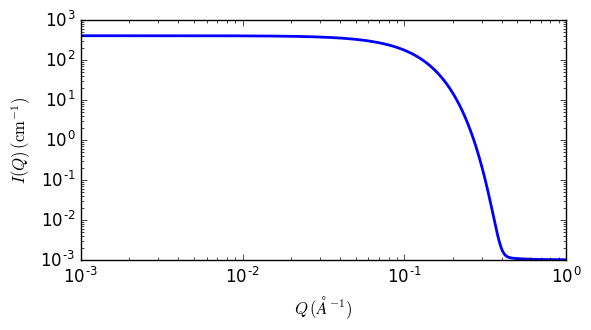unified_power_Rg
Unified Power Rg
| Parameter | Description | Units | Default value |
|---|---|---|---|
| scale | Source intensity | None | 1 |
| background | Source background | cm-1 | 0.001 |
| level | Level number | None | 1 |
| rg[level] | Radius of gyration | Å | 15.8 |
| power[level] | Power | None | 4 |
| B[level] | cm-1 | 4.5e-06 | |
| G[level] | cm-1 | 400 |
The returned value is scaled to units of cm-1 sr-1, absolute scale.
Definition
This model employs the empirical multiple level unified Exponential/Power-law fit method developed by Beaucage. Four functions are included so that 1, 2, 3, or 4 levels can be used. In addition a 0 level has been added which simply calculates
The Beaucage method is able to reasonably approximate the scattering from many different types of particles, including fractal clusters, random coils (Debye equation), ellipsoidal particles, etc.
The model works best for mass fractal systems characterized by Porod exponents between 5/3 and 3. It should not be used for surface fractal systems. Hammouda (2010) has pointed out a deficiency in the way this model handles the transitioning between the Guinier and Porod regimes and which can create artefacts that appear as kinks in the fitted model function.
Also see the Guinier_Porod model.
The empirical fit function is:
where
For each level, the four parameters \(G_i\), \(R_{gi}\), \(B_i\) and \(P_i\) must be chosen. Beaucage has an additional factor \(k\) in the definition of \(q_i^*\) which is ignored here.
For example, to approximate the scattering from random coils (Debye equation), set \(R_{gi}\) as the Guinier radius, \(P_i = 2\), and \(B_i = 2 G_i / R_{gi}\)
See the references for further information on choosing the parameters.
For 2D data: The 2D scattering intensity is calculated in the same way as 1D, where the \(q\) vector is defined as

Fig. 109 1D plot corresponding to the default parameters of the model.
References
G Beaucage, J. Appl. Cryst., 28 (1995) 717-728
G Beaucage, J. Appl. Cryst., 29 (1996) 134-146
B Hammouda, Analysis of the Beaucage model, J. Appl. Cryst., (2010), 43, 1474-1478